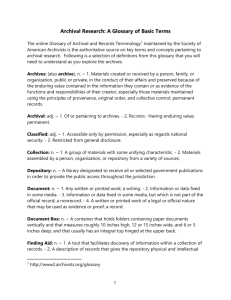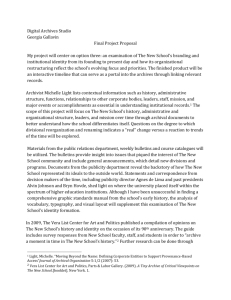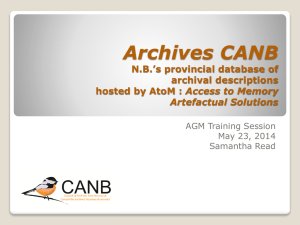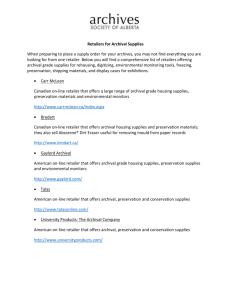Handout for Archival Description Assignment
advertisement
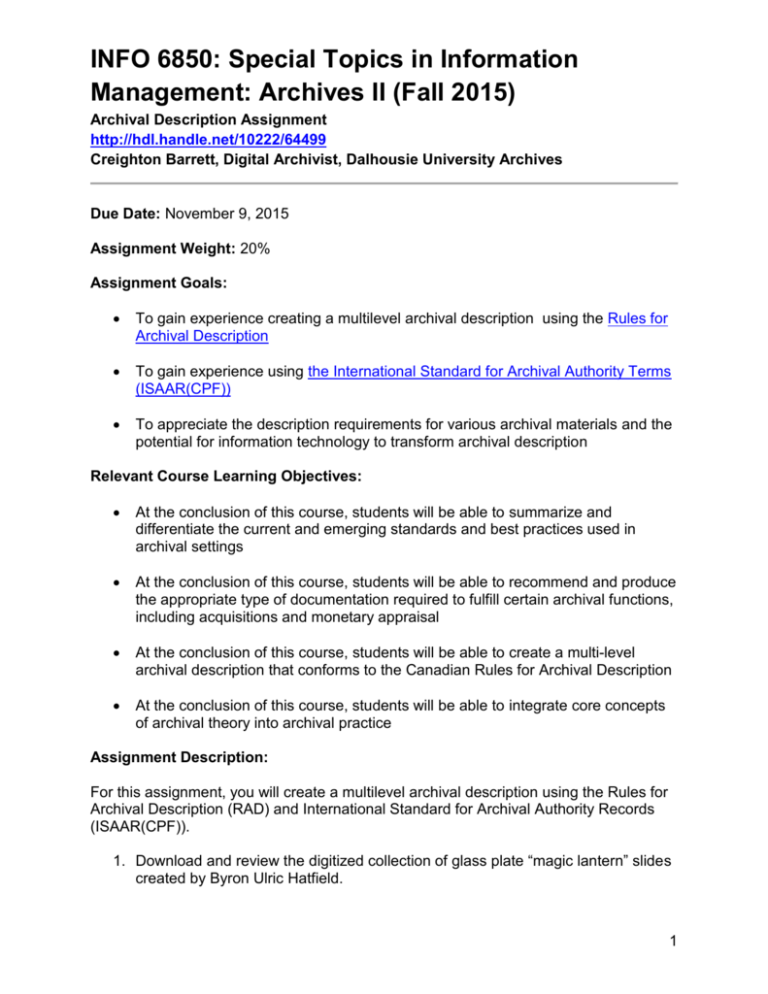
INFO 6850: Special Topics in Information Management: Archives II (Fall 2015) Archival Description Assignment http://hdl.handle.net/10222/64499 Creighton Barrett, Digital Archivist, Dalhousie University Archives Due Date: November 9, 2015 Assignment Weight: 20% Assignment Goals: To gain experience creating a multilevel archival description using the Rules for Archival Description To gain experience using the International Standard for Archival Authority Terms (ISAAR(CPF)) To appreciate the description requirements for various archival materials and the potential for information technology to transform archival description Relevant Course Learning Objectives: At the conclusion of this course, students will be able to summarize and differentiate the current and emerging standards and best practices used in archival settings At the conclusion of this course, students will be able to recommend and produce the appropriate type of documentation required to fulfill certain archival functions, including acquisitions and monetary appraisal At the conclusion of this course, students will be able to create a multi-level archival description that conforms to the Canadian Rules for Archival Description At the conclusion of this course, students will be able to integrate core concepts of archival theory into archival practice Assignment Description: For this assignment, you will create a multilevel archival description using the Rules for Archival Description (RAD) and International Standard for Archival Authority Records (ISAAR(CPF)). 1. Download and review the digitized collection of glass plate “magic lantern” slides created by Byron Ulric Hatfield. 1 INFO 6850: Archival Description Assignment 2. Download and review the associated documentation about Hatfield. 3. Read the relevant assigned readings and review associated handouts and seminar slides. Comprehension of these materials is essential to successfully completing the assignment. 4. Analyze the collection of materials. Possible approaches include: a. Examining the photographs in terms of their informational and evidential value b. Examining the photographs in terms of their aesthetic value c. Examining the photographs in terms of their creation and use d. Examining the relationships between photographs 5. Prepare a multilevel archival description that includes: a. A fonds- or collection-level description b. An ISAAR-CPF authority record linked to the fonds- or collection-level description c. At least 25 item-level descriptions 6. Make sure the entire finding aid conforms to the general rules outlined in Section 1.0 of RAD. In particular, you must ensure that each archival description contains the mandatory elements for the first level of detail of description outlined in RAD rules 1.0D1 through 1.0D3. 7. Consider adding additional notes as necessary (e.g., related materials notes, rights notes, terms governing use, etc.). The intention is to create a rich description of the materials. 8. Submit your multilevel description via the course website. Ensure that your surname is the beginning of the file name (e.g., Barrett_ArchivalDescription.docx) 9. Microsoft Word (i.e., docx) is the preferred submission format. Assignment Tips: Pay particular attention to the assignment goals, course learning objectives, and assignment evaluation criteria. They are designed to help you understand the purpose and scope of the assignment and can help formulate questions. Remember that the focus of this assignment is on multilevel description. Archival appraisal is not a component of this assignment. Consider using one of the supplied processing sheets or creating your own checklist to ensure each description has the required elements. 2 INFO 6850: Archival Description Assignment Imagine each archival description as a stand-alone record in a database. How will it look to a user when the record stands on its own? How will it look in the context of the entire multilevel description? How will it relate to other records in the database? Evaluation: The multilevel description will be evaluated according to four criteria: knowledge and expression, comprehension, application and analysis, and structure and overall presentation: 1. Knowledge and Expression (25 points) – The multilevel description will be evaluated for evidence of your knowledge of the principles and practice of archival description. This includes an assessment of your description’s adherence to the principles and general rules outlined in RAD. The description will also be assessed for clarity, grammar, syntax, and other elements of writing style. 2. Comprehension (25 points) – The multilevel description will be evaluated for evidence of your comprehension of the mandatory rules outlined in RAD. This includes an assessment of the multilevel description’s completeness and inclusion of the mandatory elements for the first level of detail of description outlined in RAD rules 1.0D1 through 1.0D3. 3. Application and Analysis (40 points) – The multilevel description will be evaluated for evidence of your ability to apply RAD and ISAAR(CPF) to the archival materials in question. This includes an assessment of the access points and each data element’s adherence to the relevant rule in RAD. This component also evaluates your effort to analyze and understand the archival materials in question. 4. Structure and Overall Presentation (10 points) – The structure of your multilevel description will be assessed in terms of layout, formatting, and readability. The overall presentation of your description will be assessed in terms of its ability to serve as research tool for researchers, archivists, and other potential users. Marks: Marks will be provided in letter grades that conform to the School of Information Management’s Grading System: http://www.dal.ca/faculty/management/school-of-information-management/currentstudents-site/sim-grading-policy.html Please feel free to consult me if you have any questions about the grading of your work. 3

